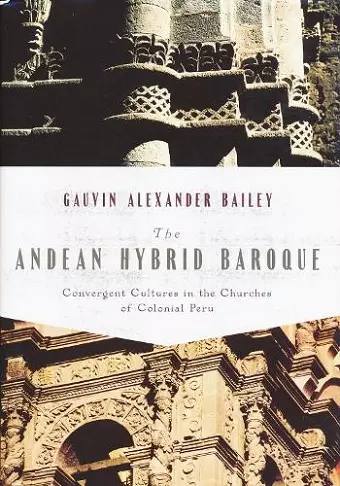The Andean Hybrid Baroque
Convergent Cultures in the Churches of Colonial Peru
Format:Hardback
Publisher:University of Notre Dame Press
Published:15th Oct '10
Should be back in stock very soon

The Andean Hybrid Baroque is the first comprehensive study of the architecture and architectural sculpture of Southern Peru in the late colonial period (1660s-1820s), an enduring and polemical subject in Latin American art history. In the southern Andes during the last century and a half of colonial rule, when the Spanish crown was losing its grip on the Americas and Amerindian groups began organizing into activist and increasingly violent political movements, a style of architectural sculpture emerged that remains one of the most vigorous and creative outcomes of the meeting of two cultures. The Andean Hybrid Baroque (also known as "Mestizo Style"), was a flourishing school of carving distinguished by its virtuoso combination of European late Renaissance and Baroque forms with Andean sacred and profane symbolism, some of it originating in the pre-Hispanic era. The Andean Hybrid Baroque found its genesis and most comprehensive iconographical expression in the architecture of Catholic churches, chapels, cloisters, and conventual buildings.
Drawing on hundreds of primary documents and on ethno-historical and anthropological literature that has rarely been applied to an art-historical subject, Gauvin Alexander Bailey provides the most substantial study of colonial Peruvian architecture in decades. The product of five years of photographic surveys in Peru, Bolivia, and Argentina, as well as research in governmental and ecclesiastical archives in Latin America and Europe, Bailey's richly illustrated study examines the construction history and decoration of forty-four churches. It offers a fundamentally new understanding of the chronology, regional variations, and diffusion of the Andean Hybrid Baroque style, as well as a fresh interpretation of its relationship to indigenous Andean culture.
“This book has two contributions of note. First, the gallery of photographs provides an invaluable resource to scholars interested in the material at hand. Second, Bailey’s documentary transcriptions in the appendices are certain to be mined by future scholars. . . . With these inventories laid forth by Bailey, the book advances a consideration of the periphery of the Spanish colonial world as a dynamic place of architectural, sculptural, and social innovation deserving further study.” —Art Bulletin
“[A]rt and architectural history are still bound to centuries-old ideas of purity, and The Andean Hybrid Baroque is an important step towards liberating art and architecture from the idea of purity and the consequent exclusion of alterity.” —Bulletin of Latin American Research
“. . . the book’s highly systematic and methodical approach and the wealth of information that is contained within it, so painstakingly researched and brought together, enables the book to do exactly what [Bailey] says it will do and solidly fills the gaps that have hitherto been left in scholarship on the theme. . . this work is an impressive and necessary keystone for any future scholar of religious architecture in the colonial Andes.” —Ecclesiastical History
“Dealing with the late colonial period (1660s–1820s), Gauvin Alexander Bailey . . . [presents a] pioneering and reliable, detailed survey Renaissance scholars can attach to their knowledge of the sixteenth century architecture and anthropology.” —Bibliotheque d’Humanisme et Renaissance
“In this ambitious and lavishly illustrated volume Gauvin Alexander Bailey reconsiders the imagery carved on the stone facades and portals of a group of colonial churches in present-day southern Peru and northern Bolivia. More than 170 photographs display the visual opulence and lush variety of the ornamentation. . . . His research demonstrates that that notion of ‘hybridity’ in colonial Latin American visual culture is still very much an issue in scholarship today.” —The Americas
“In a field which has long been populated by ‘anonymous’ or ‘unknown’ masters, Bailey does important work bringing to light the names of indigenous, mestizo, black, criollo, and European craftsmen, artists, and architects, illustrating the complexity of the artistic and political situation during the colonial era.” —Renaissance Quarterly
“Gauvin Alexander Bailey’s new book will surely become a textbook and standard resource for Andean art and architecture. With exciting insights into the colonial period in the southern Andes for the avid reader, and with original archival research for the inquisitive scholar, The Andean Hybrid Baroque challenges many of the facile suppositions about the indigenous and European cultural encounter and religious worldview. The author examines church facades in Peru and Bolivia, dating and scrutinizing the detailed carving work of native artists and combining that visual information with the testimony of colonial historians, inquisition records, and the images on textiles and queros (drinking cups). The result is an original and nuanced contribution to Andean scholarship.” —Jaime Lara, University of Notre Dame
“Gauvin Alexander Bailey’s The Andean Hybrid Baroque is a magnificent and ambitious study that not only covers an important geographic area of the southern Andes but also encompasses, in an informative and ordered style, a complex and dense constellation of pre-Hispanic and European cultural references in constant change.” —Ramón Mujica Pinilla, Universidad de San Marcos, Lima, Peru
ISBN: 9780268022228
Dimensions: 254mm x 178mm x 43mm
Weight: 1609g
808 pages